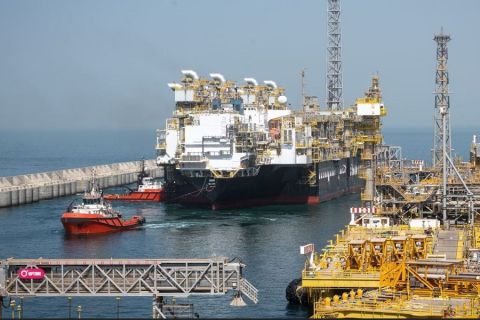
(Source: Hart Energy; Shutterstock.com)
A global pandemic wasn’t about to interrupt the Spring 2020 Reservoir Characterization Project (RCP) meeting at the Colorado School of Mines.
Due to the State of Colorado’s safer-at-home requirement in response to COVID-19, the meeting, normally held on-campus, was held via online conference in late April so that student program participants and sponsors could still share research focused on improving unconventional and conventional reservoir characterization for field production and development both onshore and offshore.
More than 20 RCP students and over 100 sponsors partook in this year’s program from locations including Norway, Brazil, the Middle East, Asia and numerous places in the U.S.
According to program director Dr. Ali Tura, “We had several dedicated students that made each piece go smoothly for the video conferencing choices, testing, and the reports, including our Ph.D. student, Mr. Aleksei Titov, who was key in organizing and checking the video conferencing component. The RCP group also delivered a 300-page report, thanks to the efforts of Ms. Mindygaliyeva who compiled the report.”
Noelle Vance, RCP’s program manager, also noted the efforts of post-doctoral candidate, Mr. Bin Luo. “He led the group of student moderators, and because of them, the presentations were delivered on-time and very professionally.”
RCP is part of the Department of Geophysics at Colorado School of Mines, a public research university dedicated to engineering and applied sciences in Golden, Colo.
The Colorado School of Mines’ RCP research highlights the value of applied research in predicting reservoir performance and enhancing field development strategies with a focus on integrated reservoir characterization. The group’s research spans geophysics, geology, petrophysics and petroleum engineering, with seismic methods as a foundation of applied studies.
Founded in 1983 as an independently-sponsored research consortium, RCP is widely recognized as an early leader in advancing research of key technologies for 4D multi-component seismic applications. RCP’s unique model emphasizes a multidisciplinary team approach for practical research, collaborating as an academic consortium with industry partners and developing graduates with a broad background of research experience and knowledge.
Applied research field projects cover a variety of geologic settings, with an emphasis on unconventional shale reservoirs. R&D areas explore the applicability and value of leading-edge technologies.
Eagle Ford
Bin Luo: Estimating seismic velocity and layer thickness of Eagle Ford using microseismic guided waves in downhole distributed acoustic sensing records.
The Eagle Ford study was conducted with data from the rich gas section of the shale play in Gonzales County, Texas
By analyzing guided waves in downhole digital acoustic sensing (DAS) records, Luo’s plan was to develop accurate physical models of the behaviors in unconventional reservoirs, establish analytic procedures to extract useful information from guided waves in downhole DAS recordings and use this data to provide qualitative constraints on unconventional reservoir thickness and velocity profile.
Two parallel wells were drilled into the conventional reservoir, well A and well B, with well A being the monitored well with the DAS fiber optic sensor and well B as the treatment well.
“We selected 17 events near the toe of the well with clear guided wave signals and used the average for the inversion to give the best fitting models and compared them to the well log results. With this, were able to explain all of the dispersion measurements obtained in the data.”
Future work includes 3D wave modeling for investigation of microseismic source and DAS receiver patterns, using 2D reservoir tomography along the DAS fiber and time-lapse velocity variations (fractured versus unfractured areas).
According to Luo, the study could show a viable means to provide quantity-control on both layer thickness and shear wave velocity of shale using the microseismic guided waves acquired by downhole DAS fiber. He also said that this method could be promising as cost-effective downhole surveys and more fracture systems are being equipped with fiber cable.
Owen Huff: Analysis of guided waves excited by microseismic events in Eagle Ford DAS data.
According to Mr. Huff, guided waves are similar to surface waves that propagate along low-velocity layers bounded by high-velocity layers and they are dispersive and exist in different harmonics.
“We know that surface microseismic data has large depth uncertainty and in the case of a thin reservoir like the Eagle Ford, this uncertainty can be greater that the reservoir thickness. This is a problem because when analyzing data related to fracturing, we want to know what events are occurring in the reservoir itself.”
The method proposed to solve the problem is to compare the energy distribution of guided waves versus body waves, first in synthetic data, then in field data. “Events with strong guided waves will be very close to the Eagle Ford, while events with weak or no guided energy will be outside the Eagle Ford.”
“There is a strong velocity contrast between the Eagle Ford and its bounding layers [Austin Chalk and Buda Limestone] and this is what causes the Eagle Ford to act as a wave guide. The Eagle Ford is relatively thin in the study area [about 40-50 m thick].”
The data was collected using a DAS monitor well in the Lower Austin Chalk and a stimulating well in the Eagle Ford (vertically, about 30 m apart). Data was recorded in the monitor well during fracturing (channel spacing of 8 m, a gauge length of 14 m and a sampling rate of 2 kHz). A surface array was installed and recorded the same events, which provided the estimated event depths, which have large uncertainty to remediate.
The goal of the monitoring was to test the relative strength of between guided waves and body waves and analyze how it compared to the event depth. They built a model synthetic data and extended it to field data. The synthetic wave data changed with event depth—the events in the Eagle Ford had strong guided wave energy compared to the other two formations (Austin Chalk and Buda).
They sought to make the differentiation between body and guide waves more apparent by transforming the data to frequency phase velocity space because guided waves are more dispersed and they will show clear trends in this domain.
The findings in the model showed where the surface seismic placed the events in terms of depth. Two events without guided waves were placed 3 m and 13 m within the Eagle Ford while the two events with strong guided waves were placed 16 m and 69 m outside of the Eagle Ford.
“Based on the criterion of how Eagle Ford events are created, this is the opposite of what we should expect, and we can confirm that the catalog depths are inaccurate and we can re-categorize these events where they actually originate, either inside or outside the Eagle Ford.”
“Going back to the synthetic plot of amplitude versus depth ratio, we can see that there is a reasonable place to put a cutoff amplitude ratio is about 0.9—events with a guided-to-body wave ratio of 0.9 or greater are likely Eagle Ford events.”
“After filtering the data, we can plot the inaccuracies of the catalog depths as many of the events with high amplitude ratios are placed outside of the Eagle Ford. By applying our method, events thought to be outside the reservoir can be brought back to a more accurate position and analyzed as such.”
More complex modeling would help establish the sorting criterion—modeling would ideally use a more representative microseismic source mechanism, such as a double-couple source and it would also account for the attenuation of higher frequency energy. It is also important to account for anisotropy in the modeling and dispersion curve calculation.
Kaveh Amini: Compositional reservoir modeling.
The object of the research is to construct a representation of a dynamic Eagle Ford reservoir model using an existing RCP project static reservoir model as the underlying framework. The study would match model performance against production data.
It would:
- Forecast production with the numerical model and the decline curve analysis;
- Optimize well spacing;
- Evaluate enhanced condensate recovery (ECR) potential of gas; and
- Document construction of a dynamic reservoir model, emphasizing grid construction for future RCP researchers.
They monitored five wells, A1, B1, C1, R1 and J1 plus modeled wells A1, B1 and C1 as well as decided on testing for their model with results from well A1. The model best matched the production history of well A1 and it correctly forecast the future production of it. It also showed that the injection of methane or any dry gas would produce a significant amount of condensate and recovery.
Multi-phase rate transient analyses of the five wells and pressure build-up showed that the effective fracture permeability is 0.01 to 0.03 milliDarcies.
“The wells in the three landing zones (in Eagle Ford) had a similar expected ultimate recovery (EUR) while the wells in the region between Austin Chalk and the Eagle Ford had the highest gas EUR. Completion design, according to the study, played a major role in the EUR in that some of the earlier wells had very small fracs relative to what is being pumped now.”
For the next RCP meeting, Kaveh said he will document the construction of the dynamic model including building an accurate numerical grid for the model, run the model for different well spacings to determine recovery factors and economics and asses gas injection to produce gas-rich condensate in the study area.
North Sea Norway, Edvard Grieg Field
Sima Daneshvar, Payson Todd
The students were working with data from 2016-2018 OBC 4D data provided by Lundin Energy from 25 wells in the Norwegian North Sea.
The goals were to evaluate potential benefits of PS data to characterize reservoir heterogeneity and effects of development with 4D, pre-stack joint inversion/PPT for geomechanics and well planning.
Dynamic reservoir from pre-stack, joint PP/PS inversion was used to constrain and update the stimulation model. According to the students, using only PP waves provided good quality data at large angles, which are needed for a reliable S-impedance or possibly density inversion—this is challenging because of the critical reflection of the reservoir’s top chalk layer that seals the reservoir and is 34 degrees—amplitudes higher than that are not reliable. There are no large offsets for the PP data—using PS data with the same limited offset could allow for a more reliable extraction of shear impedance. The shear impedance can be used to improve the static and dynamic reservoir model.
During the study, they found that PP seismic data from the field does not provide a useful impedance estimate. Even with limited angle range and heterogeneous overburden, PS data still provides improved S-impedance capable of facies identification and separation, and better understanding of the separation of pressure and saturation effects.
Recommended future work could include azimuthal analysis to lessen the injectite effect and time-variant, time-shift analysis for correction; perform a delta inversion parameter analysis for anomaly detection and backing for manual adjustments to covariance matrix and to create saturation versus pressure plots with other seismic attributes like amplitude difference.
Kuwait
Liwei Cheng: Multi-mineral analysis and reverse time migration modeling in Raudhatain Field.
The early Jurassic gas field in the northwestern part of the country and the study focuses on the Marrat formation. The Marrat was deposited on carbonate-evaporate platform and is about 2,000 ft thick, The Middle Marrat is the most prolific unit and it consists of a sequence of limestones with anhydrite, dolomites and occasional shales. The formations total porosity is up to 20% and it produces from 2,500-5,000 bbl/d of oil and 6-20 MMcf/d of gas per well.
The field has been producing since the 1950s and Jurassic test wells were drilled between 2002 and 2006 and discovered gas in deeper Jurassic layers at 14,000-16,000 ft.
“We have data from 130 square kilometers of surface seismic and seven wells with VSP data. We will be using seismic data and well log data to integrated reservoir characterization.”
“Multi-mineral log analysis is looking at the minerals and fluids from the wellbore, with downhole logging data from gamma-ray, neutron porosity, density and resistivity and the logging data is calibrated with mud logs, core and water data to develop a bulk modulus log.”
The second part evaluates the current limitations of the current seismic data. “Some of the potential imaging issues are related to the overburden where there is a high-velocity carbonate layer over the reservoir. There are also interbedded salt and anhydrite beds, and the refracting coefficients are can be 0.33 compared 0.13 in the reservoir.”
The study looks at the current field seismic data and uses reverse time migration to generate a synthetic acoustic model to develop the final convolution model. Using the convolution model, they could view apparent dip errors and blurs in the imaging. The next steps for the study will be to explore novel multiple attenuation records, such as Marchenko methods on the current seismic data. They will also use zero-offset and 3D VSPs to better evaluate the effects of internal multiples and converted waves in seismic imaging and evaluate near-surface velocity variations.
Nadima Dwihusna: Seismic and Well Log-based Machine Learning Facies Classification in the Raudhatain Field.
Ms. Dwihusna previously presented studies on developing supervised machine learning and now she is working with semi-supervised and unsupervised machine learning.
“For this study, we were using gamma-ray, bulk density, neutron porosity and resistivity and, sonic logging tools from 76 wells and the logs were unlabeled. In addition, they also had a 3D post-stack seismic data.”
In the middle of the field lies a deep anticlinal structure. Data collected between the highest and deepest part of the anticline had the highest signal-to-noise ratios and it created data problems.
The machine learning objective will be to develop a classification workflow to map the facies in the upper and lower Jurassic reservoirs. It will also be used to optimize reservoir characterization and update the geological model with the seismic facies.
For the second case study using unsupervised machine learning, they used seismic attributes key to develop a self-organizing map to create a visualization tool for seismic interpretation.
Argentina
Atilas Silva: Rock physics modeling for quantitative seismic characterization of tight sandstones in Neuquén Basin.
A project developed in Argentina’s Neuquén Basin seeks to develop a rock physics model that can represent the seismic response of tight sandstones in the study area and formulate rock physics attributes that can qualitatively characterize the seismic data. The study also attempts to characterize the understanding of the field and determine which factors drive gas migration and accumulation.
The formations tested are the Punta Rosada, Lajas and Los Molles, which are tight sandstone with low porosity (4%-10%) with a permeability of less than 0.1 millidarcies.
“The testing was limited because there was only a near stack (12-20 degrees) and a far stack (36-44 degrees) with which to work. This limited the inversion data to P-impedance Vp/Vs for inversion 1 and P-impedance and S-impedance.”
“The study area is in a basin-centered gas accumulation with anticline faults and with a collapsed graben at the crest of the anticline, which connects the source rock with the tight sandstones. The gas generation rate exceeds the dissipation rate in the tight sands and migration is driven by the high pressure, instead of buoyancy.”
The porosity of the reservoirs consists of elongated pores including fractured feldspar. He created models to predict the elastic properties of the rock in different scenarios such as using water, gas or a combination of the two.
“The attributes formulated can predict gas saturation, porosity and clay volumes in the tight sandstones, and the results matched with three wells drilling on the prospect.” He said this workflow can be characterized for this tight gas field and can also be used to identify new accumulations in frontier areas.
Recommended Reading
BP: Gimi FLNG Vessel Arrival Marks GTA Project Milestone
2024-02-15 - The BP-operated Greater Tortue Ahmeyim project on the Mauritania and Senegal maritime border is expected to produce 2.3 million tonnes per annum during it’s initial phase.
Deepwater Roundup 2024: Offshore Africa
2024-04-02 - Offshore Africa, new projects are progressing, with a number of high-reserve offshore developments being planned in countries not typically known for deepwater activity, such as Phase 2 of the Baleine project on the Ivory Coast.
E&P Highlights: March 25, 2024
2024-03-25 - Here’s a roundup of the latest E&P headlines, including a FEED planned for Venus and new contract awards.
E&P Highlights: Feb. 16, 2024
2024-02-19 - From the mobile offshore production unit arriving at the Nong Yao Field offshore Thailand to approval for the Castorone vessel to resume operations, below is a compilation of the latest headlines in the E&P space.
E&P Highlights: Jan. 29, 2024
2024-01-29 - Here’s a roundup of the latest E&P headlines, including activity at the Ichthys Field offshore Australia and new contract awards.





